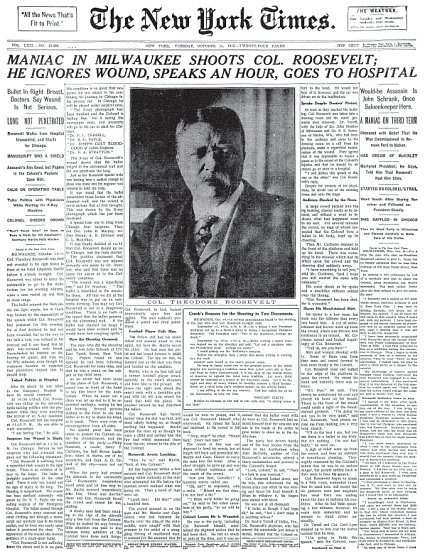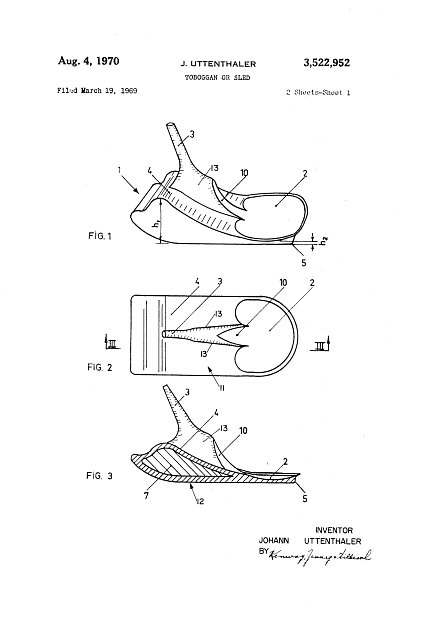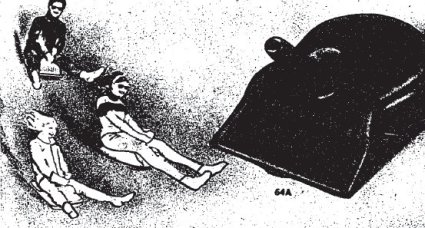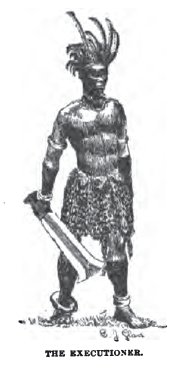More on the Roosevelt Assassination Attempt
A recent article reminded me of one of my favorite historical incidences, the attempted assassination of Theodore Roosevelt.
This is one of those events that is utterly inconcievable today: though he had been shot in the chest, he refused medical attention and demanded to give the speech he had arrived to make. He carried on extemporaneously for 50 minutes waving the bloodied notes of the speech he was going to make before finally heading to the hospital.

The New York Times. October 15th, 1912
Here is a search for all articles from the New York Times historical archives that contain “Roosevelt” for October 15, 1912, the day after the assassination attempt.
Some of the highlights:
SPEECH ROOSEVELT MADE WHILE WOUNDED.; Talking for 50 Minutes, Without Waiting for His Wound to Be Dressed, the Colonel Says He is Uninterested in Whether He is Shot or Not, and That His Concern is for Many Other Things and Not in the Least for His Own Life.
MILWAUKEE, Oct. 14. — Col. Roosevelt spoke fifty minutes at the Auditorium after being wounded.
Bullet In Right Breast, Doctors Say Wound Is Not Serious.; LUNG NOT PENETRATED
MILWAUKEE, October 14. — Col. Theodore Roosevelt was shot and wounded in the right breast in front of the Hotel Gilpatrick shortly before 8 o’clock to-night. Col. Roosevelt was about to enter his automobile to go to the Auditorium for his evening address, when a man rushed up and fired at close range.
Manly stuff.
Incidentally, I recently discovered that Martin Scorsese is making a movie based on probably the best book ever written about him, The Rise of Theodore Roosevelt. The book chronicles Roosevelt’s life up to the time he became president upon McKinley’s assassination.

What Ever Happened to the MiniBob?
Below is a picture of perhaps the greatest winter sled ever created, the MiniBob. Anyone who was a kid in 1970s had no doubt used one of these:

The Classic MiniBob
As some old ad copy puts it:
THE MINI-BOB: the Seventies version of family fun. Easier than skiing, more mirth then sledding. Lightweight. Portable. Made of high density polyethylene. Fire-engine red with black vinyl seat.

Segment of a Gimbles Department Store Ad.
New York Times. December 17, 1970
They were the sledding version of the Big Wheel—but at least that toy has the dignity of its own Wikipedia page; by contrast, the MiniBob seems to have sunk into total oblivion. It has always been a mystery to me why they are no longer available. At some point there just weren’t any around anymore and nobody seemed to know why. I recall rumors of them having been recalled for being too dangerous, but who really knows? Perhaps it was just the memory of my father going over a jump on one—and the handle snapping off in mid-flight, leaving him to land in a mangled heap.
This ad clip indicates that they were available from a company called Recreonics, Inc.:

(See picture below)
There is still a company by that name that makes pool and other aquatic recreational equipment, but it’s unclear if this is the same company.
An American Patent for the MiniBob, i.e., TOBOGGAN OR SLED US Pat. 3522952 - Filed Mar 19, 1969, references a Norwegian patent from January, 1968. Presumably then, Recreonics Inc., was either licensing the manufacture of the MiniBob on their own or were perhaps simply distributing them for some European company.

Patent No. 3522952
Looking through The New York Times archives reveals only a single reference to a company by that name in the early 1970s – in a marriage announcement from May 13, 1973. At the time the groom was “the predisent of Recreonics, Inc. of Boston, manufacturers of leisure equipment such as inflatable boasts, and […] vice president of the parent company, Great American Industries, Inc.”
Interesting… so Recreonics was, by 1973 at least, a subsidiary of GAI. There is exactly one article available on Google with those two companies together: it mentions that GAI closed Recreonics in 1973 in a bit of consolidation. Could this be the real reason behind the MiniBob’s disappearance?
A bit more old ad copy:

Unrestrained Family Mirth—for only $14.95
Amazingly, the MiniBob seems to be making a bit of a comeback—in parts of Europe anyway, where it is also called a “Zipflbob.” Some ski resorts feature Zipflbob/MiniBob runs and there is even a competitive racing circuit. Here is a video of Bücherl Werner’s record 139km/h run.
And look: they can now be purchased directly from Amazon Germany—though the price has gone up a bit, € 25,77 (not including delivery):

The MiniBob at Amazon Germany. Put one on your Wunschzettel today.
They look a bit more well-crafted than the classic model, but since nobody has had the good sense to make them available in the U.S. as far as I can tell, I may have to get one shipped over.

Exaggeration with Maps
All maps distort whatever data they try to present. The examples below show, in increasing levels of magnitude, how badly this exaggeration can accumulate with scale. These examples aren’t being used for propaganda purposes, but illustrate how similar representations could be used in such a way.
Take this example from a recent article on foreclosures in the Chicago area:

Each red square represents a single property under foreclosure. The problem is that distortion of scale presents the problem as being much worse than it may be. At the scale of the of the image above (approximately 13 pixels per mile) each red marker represents a square of approximately 400 feet on a side. It’s enough to make it appear that the entire city about to go bankrupt. That sea of red certainly elicits a sense of an emergency.
Satellite imagery from the MODIS (Moderate-resolution Imaging Spectroradiometer) Rapid Response Project which shows near real time heat anomalies (most often associated with fires), has been used to raise awareness of slash and burn deforestation techniques.

Image courtesy of MODIS Rapid Response Project at NASA/GSFC
At this scale though each pixel represents around 1000 square miles. Looking at the image its not hard to imagine that the entire world is aflame.
Perhaps most exaggerated of all though has to be the images that are typically given to show the accumulation of “space junk“—remnants of space flights and defunct satellites, etc.

In this image each pixel represents approximately 114 miles; so a piece of debris the size of a car is marked with a point the size of Long Island - easily a 6 order of magnitude exaggeration.
“The Map is not the Territory.”

Execution Ceremony
Several years ago an end-piece in New Scientist magazine asked that timeless question, “How long is one aware after being beheaded?”
Among the reader comments was this bit of grotesquery, so vivid it borders on the poetic:
Dr Livingstone wrote that Africans he encountered were aware that consciousness is not lost immediately. He recounts how they bent a springy sapling and tied cords from it under the ears of a man to be decapitated so that his last few moments of awareness would be of flying through the air.
John Rudge, Harlington, Middlesex
Holy cow! Could this possibly be true? After a bit of research I have to conclude that the ceremony described actually did happen—though I found no evidence that Dr. Livingstone reported this, nor that the victim was assumed to be aware of his final “journey” towards the heavens. More than likely Mr. Rudge had conflated scenes from descriptions given in modern biographies of Henry Morton Stanley (not David Livingstone.)
The first public descriptions of this style of execution come from the ethnologist Walter Hough:
A Bayanzi execution
In executing, the condemned is made to sit down on a block just behind a post, his limbs passing on each side of it. The post reaches to the height of his chin. His arms, legs, and body are tied to stakes. A strong sapling is bent down, having at its extremity a collar suspended by cords. This collar is placed around the victim’s neck, producing so great tension, that, when the executioner delivers the blow, the severed head is thrown into the air with the force of a bomb.

The circumstance which forms the subject of this paper was witnessed in November, 1884, at Loukolela, by Mr. E. J. Glave. […] So far as known by the writer, this is the first time that an account of the Bayanzi or a similar execution has ever been published. (From a letter dated June 9th 1887.)
Science, Vol. 9, No. 229. (Jun. 24, 1887)
And again, a few months later, Hough writes:
Notes on the Ethnology of the Congo
It is really in bad taste to describe an execution, but life there is so cheap and the Congo- African way of relieving a man of his head so unique that it will bear description. In order to give an éclat suitable to African taste, and to render the feat of decapitating with the weapon possible, the victim is secured to a seat and a strong sapling bent down and fastened by means of cords and a collar around his neck; then, while his neck is taut the high executioner delivers the blow, and the severed head is thrown into the air like a bomb.
The American Naturalist, Vol. 21, No. 8. (Aug., 1887)
E. J. Glave, mentioned by Hough above, did not write publicly about these events until an April, 1890 article for Century Magazine. Glave,who was only 18-years old at the time, was an adventure seeker who had been left in charge of the Loukolela camp by Stanley himself on his journey up the Congo River. Glave writes:
Slave Trade in the Gongo Basin
A Pole is now planted about ten feet in front of the victim, from the top of which is suspended, by a number of strings, a bamboo ring. The pole is bent over like a fishing-rod, and the ring fastened round the slaves neck, which is kept rigid and stiff by the tension.

An unearthly silence succeeds. The executioner wears a cap composed of black cocks feathers; his face and neck are blackened with charcoal, except the eyes, the lids of which are painted with white chalk. The hands and arms to the elbow, and feet and legs to the knee, are also blackened. His legs are adorned profusely with broad metal anklets, and around his waist are strung wild-cat skins. As he performs a wild dance around his victim, every now and then making a feint with his knife, a murmur of admiration arises from the assembled crowd. He then approaches and makes a thin chalk mark on the neck of the fated man. After two or three passes of his knife,.to get the right swing, he delivers the fatal blow, and with one stroke of his keen-edged weapon severs the head from the body. The sight of blood brings to a climax the frenzy of the natives: some of them savagely puncture the quivering trunk with their spears, others hack at it with their knives, while the remainder engage in a ghastly struggle for the possession of the head, which has been jerked into the air by the released tension of the sapling. As each man obtains the trophy, and is pursued by the drunken rabble, the hideous tumult becomes deafening; they smear one anothers faces with blood, and fights always spring tip as a result, when knives and spears are freely used.
The Century Magazine, Volume 39, Issue 6. (Apr. 1890)
Herbert Ward, a companion of Stanley, wrote a description for Scribner’s Magazine several months earlier. It is unclear if Ward actually witness these events, but the text is so similar to Glave’s (who is shown to have been a witness in 1884 by Hough above) one can only assume Ward had been given access to Glave’s notes or his letters to contemporaries (perhaps Stanley himself.)
Life Among the Congo Savages
The victim is placed on a block of wood, with his legs stretched out stiff in front of him. Beside each ankle a small stake is driven firmly into the ground, the same at the knees and at the sides, running up under the arm-pits. These are then firmly bound together by cords, securing the body rigidly in its position. His head is then placed in a kind of cage formed by a ring of cane fastened round the neck with numerous strings attached to it which are drawn up over the head and tied together in a loop. A pliant young sapling is now stuck in the ground about twelve feet from the victim and bent over toward him until the extreme end is caught in the loop, and all the strings round the ring are drawn taut and the neck stretched stiff by the strain.
The executioner then makes his appearance, escorted by the young men and women of the village, each holding over him a palm-leaf, forming a kind of canopy. On reaching the victim they fall back and leave him there alone. He wears a cap formed of large black cock’s tails; his face is blackened with charcoal down to the neck; his hands and arms are also blackened up to the elbows, and the same with his legs down to the knees. Around his loins he wears several wildcat skins. Standing in front of his victim, he makes at first two or three feints with his knife, to get a proper swing. Then, deliberately bending down and taking a piece of chalk, put there for the purpose, he draws a thin line around the neck, and putting a little fine sand on his hand so as to get a good grip, with one quick blow with his knife, severs the head from the trunk. Until just before the execution the whole village is wild in expectation of the event. Groups of dancers are to be seen, drummers at work, and every kind of musical instrument to add to the tumult. The head, after being severed, is jerked up in the air by the released tension of the pole.
Scribner’s Magazine, Volume 7, Issue 2. (February 1890)
In a biography of Stanley, “The Man Who Presumed”, (1957) the author, Byron Farwell, describes this same execution technique though this time witnessed by yet a third acquaintance of Stanley, Lieutenant Alphonse Vangele, at the Equator station, near to Glave’s camp.
In the same passage Farwell relates another anecdote of Herbert Ward (mentioned above):
Herbert Ward, another of Stanley’s officers, recorded seeing a similar ceremony. Just before one of the slaves was to be decapitated, however, a relative of the dead chief came up to the doomed slave and gave his a message to relay to the spirit of the departed. He concluded his message with: “… and tell him when you meet, that his biggest war canoe, which I inherit, is rotten.”
Ward himself had written about this event in his book A Voice from the Congo (1910), p. 162.
So, finally what does this say about the comment from Mr. Rudge of Harlington, Middlesex? It seems clear to me that he got the core of the story correct, just accidentally confused Livingstone with Stanley. And that dark bit of poetry about the victim’s “last few moments of awareness would be of flying through the air” was possibly a conflation of the Ward anecdote to with the more extreme beheading story.

